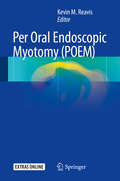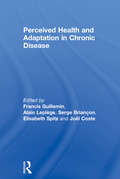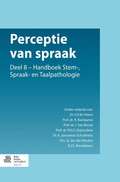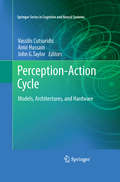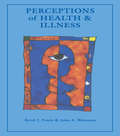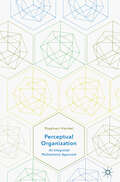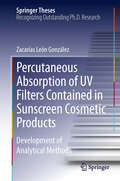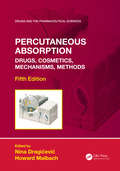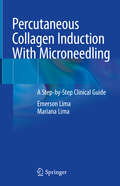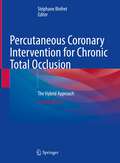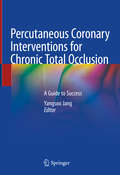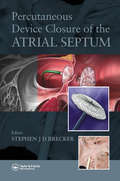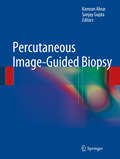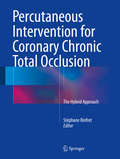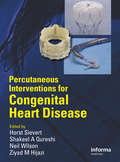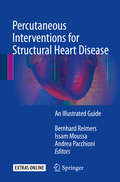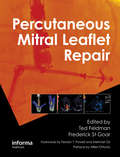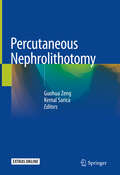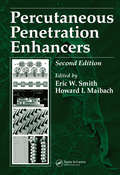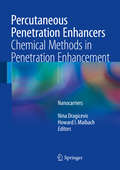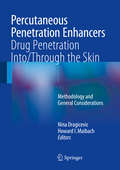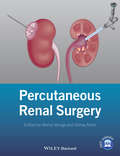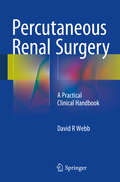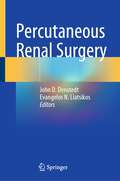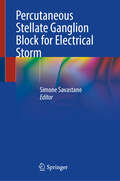- Table View
- List View
Per Oral Endoscopic Myotomy (POEM)
by Kevin M. ReavisThis text is designed to present a comprehensive and state-of the-art approach to the current and future status of POEM. Sections address preliminary issues faced by surgeons and gastroenterologists who are interested in implementing this procedure into their treatment armamentarium. These areas include the evolution of the technique, training and credentialing, as well as tools and platforms commonly used for POEM. Subsequent chapters focus on specific disease processes, and future applications of the technique. Written by experts in POEM, Per Oral Endoscopic Myotomy (POEM) addresses patient selection, pre-operative considerations, technique, and avoiding complications. A brief editorial review of the existing literature addressing the particular topic follows in each section. The text concludes with chapters on emerging and future applications. Extensive endoscopic images and illustrations make this an interactive text for General Surgeons, Surgical Endoscopists, Gastroenterologists, and associated sub-specialists.
Perceived Health and Adaptation in Chronic Disease
by Francis Guillemin Alain Leplege Serge Briancon Elisabeth Spitz Joel CosteChronic diseases have become predominant in Western societies and in many developing countries. They affect quality of life and daily activities and require regular medical care. This unique monograph will bring readers up to date with chronic disease research, with a focus on health-related quality of life and patient perception of the impact of the diseases and health intervention, as well as psychological adaptation to the disease. It considers the application of concepts and measures in medical and psychological clinical practice and in public health policies. Informed by theory, philosophy, history and empirical research, chapters will indicate how readers might advance their own thinking, learning, practice and research. The book is intended to be provocative and challenging to enhance discussion about theory as a key component of research and practice. Perceived Health and Adaptation in Chronic Disease will be of interest to researchers and academics alike. It boasts a wide range of contributions from leading international specialists from Australia, Canada, Denmark, France, Germany, the Netherlands, Spain, Sweden, the UK and the USA. This has also allowed the book to provide readers with a multidisciplinary approach.
Perceptie van spraak: Deel 8 - Handboek Stem-, Spraak- en Taalpathologie
by R. Bastiaanse P.H.O. Dejonckere K. Jansonius-Schultheiss B.J.E. Mondelaers H.F.M. Peters J. Van Borsel Sj. Van der MeulenHet Handboek Stem-Spraak-Taalpathologie verscheen tussen 1997 en 2007 gefaseerd in losse afleveringen. Daarin werd alle kennis op het gebied van de stem-, spraak- en taalpathologie vanuit verschillende disciplines samengebracht. Het Handboek is bestemd voor iedereen die klinisch-praktisch of meer theoretisch is geïnteresseerd, of vanuit een ander vakgebied hiermee in aanraking komt. Voor logopedisten, artsen, linguïsten, spraak- en taalpathologen, audiologen, pedagogen en psychologen in Nederland en België is het Handboek een onmisbare vraagbaak.Deel 8 is gericht op de auditieve waarneming van spraak. Naast de ontwikkeling van het gehoororgaan, komt ook de relatie tussen spraakperceptie en spraakproductie aan bod.
Perception-Action Cycle
by Amir Hussain Vassilis Cutsuridis John G. TaylorThe perception-action cycle is the circular flow of information that takes place between the organism and its environment in the course of a sensory-guided sequence of behaviour towards a goal. Each action causes changes in the environment that are analyzed bottom-up through the perceptual hierarchy and lead to the processing of further action, top-down through the executive hierarchy, toward motor effectors. These actions cause new changes that are analyzed and lead to new action, and so the cycle continues. The Perception-action cycle: Models, architectures and hardware book provides focused and easily accessible reviews of various aspects of the perception-action cycle. It is an unparalleled resource of information that will be an invaluable companion to anyone in constructing and developing models, algorithms and hardware implementations of autonomous machines empowered with cognitive capabilities. The book is divided into three main parts. In the first part, leading computational neuroscientists present brain-inspired models of perception, attention, cognitive control, decision making, conflict resolution and monitoring, knowledge representation and reasoning, learning and memory, planning and action, and consciousness grounded on experimental data. In the second part, architectures, algorithms, and systems with cognitive capabilities and minimal guidance from the brain, are discussed. These architectures, algorithms, and systems are inspired from the areas of cognitive science, computer vision, robotics, information theory, machine learning, computer agents and artificial intelligence. In the third part, the analysis, design and implementation of hardware systems with robust cognitive abilities from the areas of mechatronics, sensing technology, sensor fusion, smart sensor networks, control rules, controllability, stability, model/knowledge representation, and reasoning are discussed.
Perceptions of Health and Illness: Current Research And Applications
by Keith J. Petrie John A. WeinmanFirst Published in 1997. The study of how individuals perceive and make sense of health and illness is a new and rapidly developing area in health psychology. The field has seen important recent theoretical developments and applications to a wide range of health threats and illnesses. The first section of this book examines the current theoretical and measurement issues in the field and includes issues related to illness perceptions across the lifespan, disability, and the assessment of illness representations in chronic illness. The second section addresses the role of illness perceptions in health screening and prevention and includes work on perceptions of genetic disease, cancer screening, and how individuals process health risk information. The third section is concerned with the application of the illness perceptions approach to patients with chronic illness and those undergoing treatment. Illnesses examined using this approach include chronic fatigue syndrome, breast cancer, diabetes, and myocardial infarction.
Perceptual Organization: An Integrated Multisensory Approach
by Stephen HandelThis textbook goes beyond introductory sensory perception by incorporating supplementary electronic materials to demonstrate the parallels between both hearing and seeing. Each chapter intermixes seeing and hearing processes so that students can easily understand that perceptual organization is the same across different kinds of sensations and modalities. Figures illustrating visual organization are paired with sound files demonstrating the analogous auditory organization. While most books on sensation and/or perception treat the senses individually there is growing awareness of just how important multisensory integration is to understanding the connection between sensory perception and cognition.
Percutaneous Absorption of UV Filters Contained in Sunscreen Cosmetic Products
by Zacarías León GonzálezZacarías León's thesis describes the development and validation of analytical methods to estimate the processes set in motion by percutaneous absorption of UV filters in sunscreen cosmetic products. León describes these methods in both in vitro and non-invasive in vivo methodologies. Currently dermatologists recommend the use of sunscreen products not only under conditions of extreme exposure to the sun but also in daily situations. However the chemical compounds in these products contain may lead to undesired processes and cause induced toxicity, estrogenic effects and endocrine activity. León establishes methods to investigate these effects and provides valuable information on the undesired side effects associated with the use of UV filters found in sunscreen products. The work in this thesis has led to a number of publications in renowned analytical chemistry journals.
Percutaneous Absorption: Drugs, Cosmetics, Mechanisms, Methods (Drugs and the Pharmaceutical Sciences #155)
by Nina DragićevićUpdating and expanding the scope of topics covered in the previous edition, Percutaneous Absorption: Drugs, Cosmetics, Mechanisms, Methods, Fifth Edition supplies new chapters on topics currently impacting the field including cutaneous metabolism, skin contamination, exposure to protein allergens, in vitro absorption methodology and the percutaneous absorption of chemical mixtures. Complete with studies on the role of the skin as a key portal of entry for chemicals into the body, this book serves as a detailed reference source for recent advances in the field, as well as an experimental guide for laboratory personnel. Key Features: Details in vivo and in vitro methods for measuring absorption, dermal decontamination, mechanisms of transdermal delivery, and the relationship of transepidermal water loss to percutaneous absorption Considers a range of mathematical models, the safety evaluation of cosmetic ingredients, the absorption of hair dyes, nanoparticles for drug delivery, and other novel methods of drug delivery Discusses topics including skin metabolism, the skin reservoir, and the effects of desquamation on absorption
Percutaneous Collagen Induction With Microneedling: A Step-by-Step Clinical Guide
by Emerson Lima Mariana LimaPercutaneous Collagen Induction with Microneedling is a minimally invasive technique widely used to treat numerous dermatologic conditions such as facial and body scars, melasma, wrinkles, skin laxity, stretch marks, alopecies, vitiligo and scleroderma. Microneedling can also be used to optimize transdermal drug delivery for many substances. This technique uses modern microneedling devices containing multiple fine needles, typically 0.5 to 2.5 mm in length, which are mounted on a barrel and rolled onto the skin to create numerous perforations into the stratum corneum and the papillary dermis. These micro-wounds initiate the release of growth factors, triggering collagen and elastin formation, which results in dermal remodeling and skin resurfacing. This book provides a step-by-step approach to microneedling, based on the authors’ more than ten years of experience with the technique, during which they have treated more than 3,000 patients in Brazil for numerous dermatologic conditions. Richly illustrated throughout, it includes over 400 illustrations.
Percutaneous Coronary Intervention for Chronic Total Occlusion: The Hybrid Approach
by Stéphane RinfretThe second edition of this essential text provides readers with a detailed guide to performing various percutaneous coronary intervention (PCI) techniques for treating coronary chronic total occlusion (CTO). PCI continues to be an effective procedure to help patients with this pathology, with high success and low complications rates. Chapters feature a step-by-step approach to relevant techniques and describe their potential pitfalls, enabling the reader to develop a thorough understanding of how to perform those procedures successfully. Details of the latest methods for angiography analysis and the management of ostial CTOs, plus heavily revised chapters on topics such as contemporary device-based antegrade dissection and the retrograde approach through septal and non-septal collateral channels ensure that this Work remains the most up-to-date reference on the subject. Percutaneous Intervention for Coronary Chronic Total Occlusion: The Hybrid Approach represents a vital reference to assist practicing and trainee interventional cardiologist in learning these techniques. Various examples are provided, with a vast selection of still images and angiographic video loops to enable the reader become confident in applying these methodologies into their day-to day clinical practice.
Percutaneous Coronary Interventions for Chronic Total Occlusion: A Guide To Success
by Yangsoo JangThis book equips readers with the knowledge required in order to successfully treat coronary chronic total occlusion by means of percutaneous coronary interventions. All the essential background knowledge is provided, including with regard to procedurally relevant histopathology, assessment of chronic total occlusion by means of angiography and computed tomography, patient preparation, and selection and use of guidewires. Both basic and advanced techniques employing antegrade and retrograde approaches are then described in detail with the aid of numerous high-quality illustrations that ensure ease of understanding. Helpful tips and tricks are highlighted, and guidance provided on the troubleshooting of problems and the prevention and management of complications. The book will serve as a superb guide for all who are involved in percutaneous coronary interventions for chronic total occlusion, including interventional cardiologists, fellows in training, nurses, and technicians in catheterization laboratories.
Percutaneous Device Closure of the Atrial Septum
by Stephen J D BreckerThe field of device closure of defects of the inter-atrial septum has expanded rapidly over the past ten years, and it is likely that there will be a further sharp increase in numbers of procedures being performed in the near future. With more and more adult patients presenting with this problem, it is imperative that interventional cardiologists k
Percutaneous Image-Guided Biopsy
by Sanjay Gupta Kamran AhrarThis book provides a comprehensive source for all aspects of percutaneous image-guided biopsy. A synthesis of rationale, technique and evidence-based medicine, it offers a clear approach to imaging, devices, procedures and patient care. Replete with case studies, radiological images, illustrative diagrams and tables, this valuable reference is an indispensable addition to the bookshelves of all radiologists in training as well as practicing radiologists who would like to expand their biopsy service and refine their skills. The easy to follow format, organization and graphic presentations create a high-yield approach to practical information such as indications, technical considerations, anatomical considerations, outcomes and complications. This timely compendium is a necessity in this rapidly progressing field.
Percutaneous Intervention for Coronary Chronic Total Occlusion
by Stéphane RinfretA practical and technical handbook providing operators with a step-by-step description of how to perform some of the techniques involved in the procedures, and how to troubleshoot some of the problems along the way. Examples with pictures will be provided, along with live angiographies. At the end of each chapter, the author will be provided with 3 questions to answer. Those questions will be developed by the editor and the contributors. The idea is to provide a quick reference to the most current problems encountered with a specific issue developed in the chapter. Nowadays, the busy clinician is unlikely to exclusively rely on lengthy textbooks to learn specific complex techniques. That is one of the reasons for the popularity of CTO courses, live demonstrations, and conferences and, there are consequently many courses offered around the world to help new operators in the field. CTO PCI has emerged as a very effective procedure to help patients with CTOs, with very high success and low complications rates. It is however a very challenging procedure with multiple pitfalls along the way to success, both in specific cases, but also in the learning process. There are currently no single reference or "one-stop shop" for the operator who wants to learn a given technique that he or she may has seen performed live in a dedicated proctorship event, or in a live demonstration, or to even troubleshoot a problem encountered in daily CTO PCI practice. This will be the first handbook formatted for the busy interventional cardiologist. This book will become a "must have" for operators who are practicing CTO PCI and who want a quick reference. However, it will also provide tips and tricks currently used in the field.
Percutaneous Interventions for Congenital Heart Disease
by Neil Wilson Horst Sievert Sankt Katharinen Shakeel A QureshiPercutaneous Interventions for Congenital Heart Disease is written for pediatric cardiologists specializing in interventional cardiology and need a step-by-step guide to carrying out procedures, as well as adult cardiologists. Covering all kinds of interventions in congenital heart disease and the new field of structural heart disease, the book exa
Percutaneous Interventions for Structural Heart Disease
by Bernhard Reimers Issam Moussa Andrea PacchioniThis book presents the percutaneous techniques and technologies most frequently employed in structural interventional cardiology, focusing especially on how to optimize outcomes and minimize risk. Interventional procedures for aortic stenosis, mitral regurgitation, left atrial appendage closure, patent foramen ovale closure, and closure of interatrial and interventricular defects are clearly presented step by step with the aid of a wealth of images. These descriptions are complemented by a case-based analysis of the various structural pathologies and their complications. Clear guidance is also provided on patient selection, preoperative evaluation, and choice of available devices. The authors are all acknowledged experts with extensive experience in laboratories and surgical units. The book fully reflects the rapid changes in structural interventional cardiology that have occurred during recent years. These advances are in particular due to the introduction of transcatheter aortic valve implantation, which allows cardiac surgeons to achieve excellent outcomes in patients at high surgical risk. Other exciting developments include new technologies that permit better treatment of other structural cardiac pathologies and valid alternatives to medical therapy in particular patient groups.
Percutaneous Mitral Leaflet Repair: MitraClip Therapy for Mitral Regurgitation
by Ted Feldman Frederick St GoarMitral regurgitation (MR) affects millions of patients worldwide. It is a progressive condition that can worsen when left untreated, possibly leading to compensatory remodeling of the left ventricle. This can result in reduced functional capacity, poor quality of life, repeat hospitalizations, and even death from heart failure. Open, arrested heart
Percutaneous Nephrolithotomy
by Guohua Zeng Kemal SaricaThis book provides a comprehensive overview of percutaneous nephrolithotomy, covering topics including its history, anatomy, preoperative preparation, clinical operation, and postoperative treatment. It presents both basic and advanced techniques, such as micro-PNL, mini-PNL, ultra-mini-PNL, and super mini-PNL, together with representative clinical cases. In addition, the book describes potential technical issues, complications, indications and contraindications in detail, making it a valuable reference guide for urologists, especially those who wish to improve their PCNL skills in clinical practice.
Percutaneous Penetration Enhancers
by Paul C. H. LiThoroughly updated, this second edition is the most comprehensive reference on the methods available for the enhancement of percutaneous penetration. The book examines a broad scope of chemical enhancers and various physical methods of enhancement. The range of chemicals discussed is, arguably, unsurpassed anywhere in the literature. This edition contains comprehensive descriptions of the latest techniques and several chapters cover the modern analytical techniques adapted to assess and measure penetration enhancement. New to this volume are chapters addressing penetration retardation, important for substances such as sunscreen agents, for which skin penetration is not desirable.
Percutaneous Penetration Enhancers Chemical Methods in Penetration Enhancement
by Howard I. Maibach Nina DragicevicPercutaneous Penetration Enhancers in a mini-series format comprising five volumes, represents the most comprehensive reference on enhancement methods - both well established and recently introduced - in the field of dermal/transdermal drug delivery. In detail the broad range of both chemical and physical methods used to enhance the skin delivery of drugs is described. All aspects of drug delivery and measurement of penetration are covered and the latest findings are provided on skin structure and function, mathematics in skin permeation and modern analytical techniques adapted to assess and measure penetration. In offering a detailed description of the methods currently in use for penetration enhancement, this book will be of value for researchers, pharmaceutical scientists, practitioners and also students.
Percutaneous Penetration Enhancers Drug Penetration Into/Through the Skin
by Howard I. Maibach Nina DragicevicPercutaneous Penetration Enhancers in a mini-series format comprising five volumes, represents the most comprehensive reference on enhancement methods - both well established and recently introduced - in the field of dermal/transdermal drug delivery. In detail the broad range of both chemical and physical methods used to enhance the skin delivery of drugs is described. All aspects of drug delivery and measurement of penetration are covered, and the latest findings are provided on skin structure and function, mathematics in skin permeation, and modern analytical techniques adapted to assess and measure penetration. In offering a detailed description of the methods currently in use for penetration enhancement, this book will be of value for researchers, pharmaceutical scientists, practitioners, students and dermatological scientists or dermatologists.
Percutaneous Renal Surgery
by Manoj Monga Abhay RanePercutaneous Renal Surgery will provide surgeons and urologists/nephrologists with a well-illustrated, full-colour expert guide to performing these complex and difficult surgical procedures safely and effectively.Focus throughout is on percutaneous management of three major conditions: large renal calculi (percutaneous nephrolithotomy), transitional cell cancer (percutaneous resection of tumor) and renal cell cancer (percutaneous cryotherapy and radiofrequency ablation).For each of these conditions, leading surgeons and urologists will cover:Epidemiology of the diseaseEvolution of evidence-based outcomes for percutaneous managementPatient selection and informed consentInstrumentationSurgical technique10 high-quality videos of surgery in action will provide an excellent visual guide to best practice and tips/tricks while performing surgery, making this a perfect multi-media teaching tool.
Percutaneous Renal Surgery
by David R WebbThis is the first textbook devoted entirely to percutaneous renal surgery. The text explains the basic anatomy, instruments, track dilation and creation, kidney access and surgical treatment of all complex stone scenarios. The book is written in simple sections and is extensively illustrated with more than 250 illustrations. All diagrams have been drawn by the author and reproduced by a professional graphic artist. The book describes the basic techniques, then progresses clinically through to more difficult clinical and surgical scenarios. In this way, it is akin to a "cook book" in style, that is easily referenced and readable. As percutaneous renal surgery is a team effort, the book contains descriptors for ward and theatre technicians and nurses, as well as equipment lists. The book also contains a "do it yourself" six-stage percutaneous renal surgery workshop program. This workshop can be performed in any department practising PCNL. Percutaneous Renal Surgery: A Practical Clinical Handbook represents a practical manual, suitable for medical students, nurses and technicians and is a unique manual for all urology trainees and urologists treating renal stone disease worldwide.
Percutaneous Renal Surgery
by John D. Denstedt Evangelos N. LiatsikosIn the ever-evolving field of urology, percutaneous renal surgery (PCNL) for kidney stones stands at the forefront of innovation and excellence and offers an alternative to traditional open surgery. This book, Percutaneous Renal Surgery, delves into the intricacies of percutaneous renal surgery, providing a thorough exploration of the latest techniques, advancements, and best practices. Featuring contributions from international experts in the field, each chapter covers the key aspects of percutaneous renal surgery, including patient selection, preoperative evaluation, procedural nuances, postoperative care, and potential complications. From navigating renal anatomy to mastering the latest instruments and technologies, you'll gain the knowledge and confidence needed to excel in this specialized discipline. Discover the benefits of percutaneous renal surgery, such as reduced invasiveness, shorter hospital stays, enhanced patient outcomes, and improved quality of life. Explore its applications in treating kidney stones, urothelial cancer, and other urological conditions. Delve into the art of accessing the kidney through percutaneous techniques, utilizing fluoroscopy, ultrasound, and other imaging modalities.With its comprehensive coverage and insightful guidance, Percutaneous Renal Surgery empowers urologists to push the boundaries of patient care and redefine what is possible in the field of urology.
Percutaneous Stellate Ganglion Block for Electrical Storm
by Simone SavastanoElectrical storm presents a challenging cardiological emergency with limited treatment options. Pharmacological interventions are often ineffective, while non-pharmacological treatments requiring specialized skills or equipment may not be readily available. Physicians face the daunting task of stabilizing critically ill patients with recurrent ventricular arrhythmias, often with high mortality rates. Transporting patients to specialized centres for advanced treatments like transcatheter ablation or circulatory support may be necessary. Percutaneous stellate ganglion block emerges as a crucial intervention in this context. Originally developed for pain management, its antiarrhythmic potential became evident in the 1970s with the understanding of the autonomic nervous system's role in arrhythmogenesis. This manual aims to provide insights into the rationale, efficacy, safety, and execution technique of stellate ganglion block, offering a valuable addition to the therapeutic armamentarium for arrhythmic storm. It covers various aspects from ventricular arrhythmia pathophysiology to modern treatment approaches and the influence of the autonomic nervous system. The text reviews literature supporting the technique's antiarrhythmic efficacy and provides detailed guidance on its execution using anatomical landmarks and imaging.
